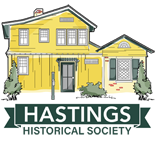
by Natalie Barry
In the past couple of months, the Hastings Historical Society has gotten several inquiries about farms that operated in our village over a 100 years ago. One inquiry came through our Facebook page, asking if we knew anything about the Curry farm located on the south side of Hastings. We received two other emails asking what was located up by Circle Drive at the top of Villard. The answer to these questions was that there were farms at both locations. Our Society volunteers knew some basic facts about the two establishments and had a couple of oral history interviews with Vira Curry McNiece, one from 1979 and one from 1983. But after reviewing the oral histories and digging into our files and our database, we learned a lot more. I’d like to share what we discovered.
The Curry Farm
Francis (Frank) M. and Mary Lane Curry were living on West 33rd Street in Manhattan when the draft riots broke out in 1863. The racial violence unleashed during that disturbance convinced them to move their family out of the city but, for awhile, they didn’t know where to go. Frank began attending auctions, buying up property, then reselling it for a small profit. In 1865, he saw an advertisement for a parcel of land in Hastings and decided that this would be a great spot for his growing family.


Circa 1866, Frank and Mary moved their brood to our village and settled into a house, already old at the time, situated on a major east-west road cutting through the southern section of Westchester County. The following is a map of the property that became the Curry farm.

The couple raised four children in that farmhouse: Francis (Frank) E., Sara Elizabeth (Lizzie), Henry, and Frederick Curry. As they were growing up, the boys help to farm the property, along with some hired help.
As an adult, the younger Frank Curry became a local judge, a Hastings village trustee, and a foreman of the Protection Engine Company. Most confusingly, he married Mary Tompkins (another couple named Frank and Mary!), whose parents ran a hotel on the corner of Saw Mill River Road and the Public Highway that later was renamed Tompkins Avenue after that family. Frank’s brother-in-law, W. Ward Tompkins, was a force in local politics and was instrumental in getting the Warburton Avenue Bridge built in 1900. (Note that much of this history of the Curry family is recounted by the younger Frank and Mary’s daughter, Vira Curry McNiece.)
Most unusually, in 1893 Frank’s sister Lizzie graduated from the Women’s Medical College of New York and became a homeopathic doctor. After practicing in the city, she returned to live with the family on what was now called Tompkins Avenue, attending to patients in northern Yonkers and along Washington Avenue in our village. Later on in her career, she saw patients at the house, charging patients 50 cents for an office visit. She charged $1.00 for house calls.

The couple’s son Frank inherited the farm after his father died. According to his daughter Vira, they “grew everything on that farm! Tomatoes (75 cents a crate), cucumbers, string beans, lima beans, watermelons, corn, everything you could think of.” They also had three or four milk cows and would bring large cans of milk on a daily basis over to a Mr. Minzer, who was a milkman in Hastings. Vira’s mother would make her own root beer and wine from the grapes on the property.


In 1900, Frank and a group of his firemen friends built a clubhouse on the Curry property and established the Punkie Barrie Fishing Club, where they would have clam and shad bakes and drink beer. The clubhouse burned down in 1930 and was never rebuilt.

There was a swimming hole on the Curry property, where Tompkins Avenus met the Saw Mill River. Many Hastings residents in the early 1900s swam and canoed there in the summer, although Vira said she was forbidden to swim in the river as a child.

Small portions of the Curry property were sold off in the 1920s. These lots were on what is became James Street and Cedar Street. A strip of land was also used for the construction of the Saw Mill River Parkway during this time period. Another piece of property was sold in the 1930s along Tompkins Avenue.
In 1947, seven acres of the Curry property were sold to a builder, Lee Hall, who developed Ronny Circle and Curry Road, the latter named after the family. In 1956, more property was sold off for the Oxford Road development. In June of 1973, five years after Vira Curry McNiece’s husband died, the house at 219 Tompkins Avenue and a little less than one acre were sold. After the sale, Vira moved into the Hastings House on North Broadway; she died in November of 1984 at age 90. The house at 219 Tompkins Avenue, one of the oldest in our village, is still standing today.

The Burger Farm
Close to 200 acres of land from Broadway going up the hill to the Dobbs Ferry border was once owned by Robert Minturn, who was a shipping magnate in the mid-19th century. Then, in the late 1800s, the section near what is now Circle Drive was part of the Burger (or Berger) farm, which our records show was a dairy operation, possibly leased from the Minturn family. Our files suggest that the Burger farmhouse stood on the site of today’s 32 Ferndale Drive. Notations in our files indicate that a family named Heidrich farmed the property for many years.

There were various outbuildings, wells and stone walls on that farm, some of which are still scattered around the area today. Tyler Jontz, who grew up in the area, said this after reading over the material we sent him about the Burger farm: “This would explain why I would find lots of metal pieces of what looked like farm equipment when I was a kid back in the 1980s/early 1990s. I had a metal detector and would go around my property and find all sorts of things. Most notably was some kind of metal stakes used for farm animals, it seems. I lived at 17 Chestnut Drive.”


Although we have no precise time frame, written records indicate that there was a fire sometime in the early part of the 20th century and the main house burned down.

Unfortunately, that’s all we know about the Burger farm. We’d love to learn more about who were the Burgers (or Bergers) and the Heidrichs, what their lives in Hastings were like, and what happened to the proprietors after the fire. If anyone could shed light on any of this, we’d love to hear from you! Contact us at hhscottage@gmail.com.
Natalie Barry is the president of the Hastings Historical Society.








I always enjoy reading about Hastings. You do a great job of collecting and writing our town’s history. Thank you
Thank you! We’re glad you enjoyed it.
Thank you for the posting on the Burger Farm and the property that went up the hill to the Dobbs Ferry line. Since I lived on that line in Hastings on Ravine Drive, I was very interested in the early history of this farm property. I had only know this area as Villard Hill, and road up the hill to the DF line as Villard Avenue. I am curious as to how the name of the property and road were changed and when?
Henry Villard (1835-1900) had a large estate in the area we now call Riverview Manor in the mid- to late 1800s. His house (no longer standing) was actually over the line in Dobbs Ferry. The driveway to his estate followed the path of today’s Villard Avenue, which was the name of the road by 1900 – that driveway is visible on the map included in the blog post. The Burger farm wasn’t as far up the hill and was located in Hastings. It only encompassed the area around today’s Circle Drive. According to the map, you could access the Burger farm either from Villard’s long driveway or via “Burger Lane,” which was an entrance closer to the current Five Corners intersection. A very small piece of that lane is still in use, although it’s now called Baker Lane.
Thank you for the article on the Curry and Burger farms. I’m curious if anyone has any insight on the Robert Minturn estate?
My wife’s grandfather is listed as a 9 year old resident in the 1900 census at “The Woodland Home Childrens Fold Mt. Minturn. I read that Robert Minturn was a philanthropist who donated some of his land for an orphanage. I have searched and searched to try to see if I could find out who might maintain records, to no avail. Do any locals ever recall their parents or grandparents talking about this place? Thanks so much!
-Steve
Good stuff as always, kudos to the researcher’s 👏
I wonder who built the potato cellar and when it was built. Is it still standing?
I’m guessing the owners of the farm built the cellar. As to whether it’s still there, that’s a good question (one that I wondered about myself). We’d have to contact whoever is living in that area now and see what they say. If we get any info on that, I’ll let you know.
So interesting. I never knew anything about which you have written. Thank you for all the in-depth research and display of relevant documents.
Fascinating article. Thank you for the research and writeup. As a followup it would be interesting to overlay a current map against the Rumseymap excerpt depicting the Burger Farm to see where Hillside Park intersects or is adjacent to the Burger Farm, including any indicator whether the water bodies to the east are present day Sugar Pond and Three Island Pond (on the Dobbs border).
David – I do think that Three Islands Pond is the one in the right-hand corner of the map. The other one is a pond that’s no longer in existence, but used to be where the pool parking lot is today. Back in the early to mid-1900s, it was called Duck Pond and was a village swimming hole. The Sugar Pond up by Hillside School was a marshy area that in the 1930s was walled off and made into an ice skating/fishing spot. It rarely appears on any maps before that time period. I’m with you about overlaying a current map on this one, though – I’m curious about whether there’s an intersection between the Curry farm circular driveway and today’s Circle Drive. If I’m able to compare two, I’ll report back.
I grew up at 100 Circle Drive, and my best childhood friend lived at 19 Circle. What a fascinating article! Great job as always, Natalie.
Thanks, Claudia.
Thank you Natalie! I believe the Currys drew all the water for the farm from a stream that originates somewhere along Cedar and/or Bevers Street (visible on the 1865 map). An old cistern or catch basin near where Cedar becomes Bevers may have been built by them originally. It was demolished last year to make way for a new house on Bevers.
Keith – Good to know.
I’m sorry it was demolished.